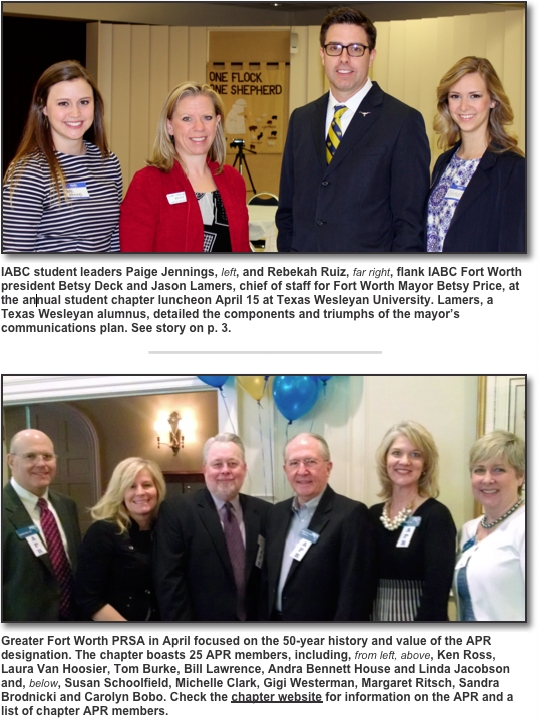



Next month: scenes from the 11th annual
First Amendment Awards and Scholarship Dinner
First Amendment Awards and Scholarship Dinner
THIS MONTH IN PR/MARKETING HISTORY BY JEFF RODRIGUEZ
An irreverent look at the people and events that keep us up at night
Rare Bird
Lindbergh’s Flight Brought More Fame Than He Ever Imagined — or Wanted
When Charles Lindbergh took off from New York City around 8 a.m. Friday, May 27, he was an obscure
25-year-old pilot just delivering the mail. Thirty-three hours later, when The
Spirit of St. Louis touched down in Paris, he was the first person to complete
a solo nonstop flight across the Atlantic. He also won the $25,000 prize
offered by a French-born hotel owner, and he instantly became one of the
biggest PR sensations in history. But there was much more turbulence to come.
As he approached Paris, some 150,000 spectators were waiting, and the headlights
of their cars made it difficult for Lindbergh to see where to go. By the time
the plane stopped rolling, the crowd had stormed the field and practically
pulled him from the cockpit. While his admirers carried him around the field on
their shoulders, souvenir hunters were busy tearing off pieces of the plane’s fabric.
Lindbergh stayed in Paris long enough to see the French Foreign Office fly the
United States flag, an honor reserved for heads of state, then he sailed home
aboard a Navy cruiser. He was escorted to Washington, D.C., where President Coolidge awarded him the Distinguished Flying Cross; that same day, the Postal Service
issued a 10-cent stamp depicting Lindbergh’s plane. (This was a time when 10 cents actually was useful.)
From there, Lindbergh’s fame grew exponentially. He enjoyed a ticker-tape parade in New York City and
a banquet with the mayor. A member of the Army Air Corps Reserve, Lindbergh
received the Medal of Honor in December. He was Time magazine’s Man of the Year for 1927.
Then there was the book. Lindbergh’s autobiography was published just two months after he landed, a remarkably fast
turnaround, made even more remarkable by how it was created. A first draft had
been ghost-written by a New York Times writer but Lindbergh thought it fawning,
and in three weeks he rewrote it — by hand. It remained a best-seller well into 1928, no doubt boosted by what may
be the most robust book tour in history.
Flying his famous plane, Lindbergh visited 82 cities in all 48 continental
states and delivered 127 speeches, all in just four months. Within a year of
his historic flight, roughly 30 million people, about one-fourth of America,
had personally seen “Lucky Lindy.” That’s better numbers than the Super Bowl pulls.
More than just popular, Lindbergh was influential in a way that the Beatles
might have envied. During the remainder of 1927, applications for pilot
licenses tripled, while the number of licensed aircraft increased four-fold,
and in the next two years the number of U.S. airline passengers increased 3,000
percent (which probably explains why flights are so crowded now). Lindbergh
designed an aviators’ watch, which Longines still produces, and he even got his name attached to a
wildly popular dance, the Lindy hop, which is believed to be named in honor of
Lindbergh’s “hop” across the Atlantic.
The tragic kidnapping of Lindbergh’s 20-month-old son, Charles Jr., occurred in 1932; the infant’s remains were found six weeks later. The crime led to the creation of yet
another legacy, the “Lindbergh Law,” which made kidnapping a federal offense in some circumstances. It also pushed
Lindbergh and his wife out of the country: Weary of all the attention, they
opted to leave. In 1935, traveling under assumed names, they moved to a small
community in England. They would not return until 1939.
With the world on the brink of war, Lindbergh took his fame in a decidedly
different direction. An outspoken opponent of U.S. intervention, he gave
speeches heard by thousands and drew the wrath of President Roosevelt; he also was accused of having sympathy for the Nazis. Indeed, in 1939 he wrote
in his diary, “Much as I disapprove of many things Hitler had done, I believe [Germany] has
pursued the only consistent policy in Europe in recent years. ... The question
of right and wrong is one thing by law and another thing by history.” Following the attack on Pearl Harbor, however, Lindbergh became a strong
supporter of the war, and he would fly 50 combat missions in the Pacific.
After the war, Lindbergh served as a consultant to an airline and the Air Force
and on a commission that would help establish the site of the future Air Force
Academy. He also became an environmentalist, campaigning on behalf of whales
and other endangered species.
Lindbergh died in August 1974 on Maui, still revered as one of the nation’s great heroes. However, he was not without his flaws: Beyond his patience with Adolf Hitler, Lindbergh was an open supporter of eugenics, and in his diary he expressed
ideas that are clearly anti-Semitic. And while he had six children with his
wife, Anne, Lindbergh rarely saw them -- perhaps due to the fact that he also
had three mistresses in Europe. With these women, he fathered seven more
children; shortly before his death, he wrote to each woman, imploring her not
to divulge their secret.
Despite this turbulence, Lindbergh remains an American icon, with schools,
airports and even research prizes named in his honor. He is a genuine American
success story and, what’s more, a genuine American PR success story. But he also serves as a reminder
that, while we all hope our dreams will take off, it’s important to think about where they might land.
=======================================================









